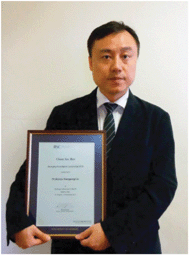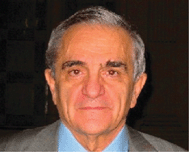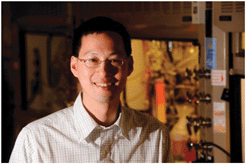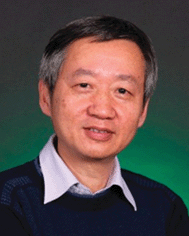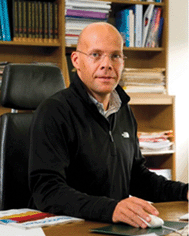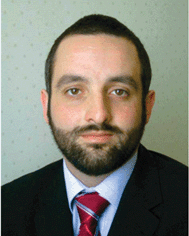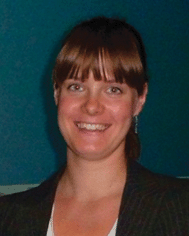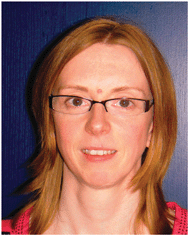Chem Soc Rev Editorial – getting back to basics…
Abstract
2012 was a landmark year for Chem Soc Rev. In this Editorial, we look back at what made it so special and forward to some new developments planned for 2013.
Growth
Following several years of significant growth, in 2012, Chem Soc Rev successfully transitioned from 12 to 24 issues. This bold statement meant that Chem Soc Rev is more flexible and able to deliver a broader and more extensive list of topical themed issues. Authors also benefit from the increase in frequency, as their reviews are published in issues sooner. As the final issue of the year closed, Chem Soc Rev has continued its monumental growth with 400 reviews published across the 24 issues. Even more impressive is that this growth has come when the journal’s rejection rate is at its highest recorded level. Compare this to our ACS counterparts and it is clear that Chem Soc Rev really is the first choice for high quality reviews (Fig. 1).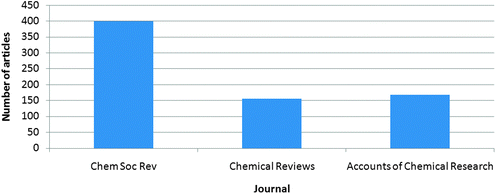 | ||
| Fig. 1 Number of reviews published in general chemistry review journals in 2012 (Chemical Reviews and Accounts of Chemical Research data taken from Scopus correct as of 3rd November 2012). | ||
Impact Factor reaches new high
Alongside the significant growth, we were also delighted to see that the Chem Soc Rev impact factor has continued to grow for the 4th year in a row to another record high (Fig. 2). This new value of 28.76 (2011 Journal Citation Reports®, Thomson Reuters 2012) firmly cements the journal as the number two ranked general chemistry review journal as well as the number two ranked journal overall in the multidisciplinary chemistry category of the Journal Citation Report®.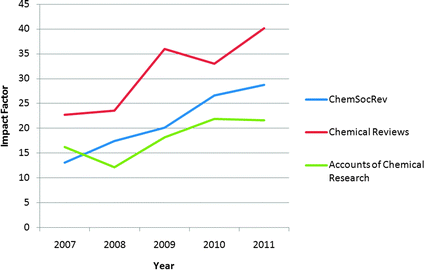 | ||
| Fig. 2 General chemistry review journal impact factors over the past 5 years. | ||
This continual growth in impact factor has been achieved by ensuring we publish reviews and themed issues in the most topical areas of research. Table 1 showcases the top ten most accessed reviews in Chem Soc Rev in 2012.
| Review type | Title and authors | DOI | Citation |
|---|---|---|---|
| Tutorial | Mesoporous silica nanoparticles in biomedical applications | 10.1039/C1CS15246G | Chem. Soc. Rev., 2012, 41, 2590–2605 |
| Zongxi Li, Jonathan C. Barnes, Aleksandr Bosoy, J. Fraser Stoddart and Jeffrey I. Zink | |||
| Design of polymeric nanoparticles for biomedical delivery applications | 10.1039/C2CS15327K | Chem. Soc. Rev., 2012, 41, 2545–2561 | |
| Mahmoud Elsabahy and Karen L. Wooley | |||
| Organocatalytic umpolung: N-heterocyclic carbenes and beyond | 10.1039/C2CS15333E | Chem. Soc. Rev., 2012, 41, 3511–3522 | |
| Xavier Bugaut and Frank Glorius | |||
| Recent advances in copper-catalyzed dehydrogenative functionalization via a single electron transfer (SET) process | 10.1039/C2CS15323H | Chem. Soc. Rev., 2012, 41, 3464–3484 | |
| Chun Zhang, Conghui Tang and Ning Jiao | |||
| Dynamic imine chemistry | 10.1039/C2CS15305J | Chem. Soc. Rev., 2012, 41, 2003–2024 | |
| Matthew E. Belowich and J. Fraser Stoddart | |||
| Critical | Graphene-based composites | 10.1039/C1CS15078B | Chem. Soc. Rev., 2012, 41, 666–686 |
| Xiao Huang, Xiaoying Qi, Freddy Boey and Hua Zhang | |||
| The chemistry of graphene oxide | 10.1039/B917103G | Chem. Soc. Rev., 2010, 39, 228–240 | |
| Daniel R. Dreyer, Sungjin Park, Christopher W. Bielawski and Rodney S. Ruoff | |||
| Heterogeneous photocatalyst materials for water splitting | 10.1039/B800489G | Chem. Soc. Rev., 2009, 38, 253–278 | |
| Akihiko Kudo and Yugo Miseki | |||
| A review of electrode materials for electrochemical supercapacitors | 10.1039/C1CS15060J | Chem. Soc. Rev., 2012, 41, 797–828 | |
| Guoping Wang, Lei Zhang and Jiujun Zhang | |||
| Recent advances in transition-metal catalyzed reactions using molecular oxygen as the oxidant | 10.1039/C2CS15224J | Chem. Soc. Rev., 2012, 41, 3381–3430 | |
| Zhuangzhi Shi, Chun Zhang, Conghui Tang and Ning Jiao |
We realise however that it’s not just about the impact factor and that’s why we try to balance the journal with reviews and themed issues in areas of research from across the whole of the chemical sciences. As you can see from Table 2, the breadth of science covered in our themed issues in 2012 touches on everything from physical to supramolecular chemistry and materials to aspects of medicinal chemistry.
| Issue | Subject | Guest editors |
|---|---|---|
| 4 | Green chemistry | CJ Li and Paul Anastas |
| 7 | Nanomedicine | Frank Caruso, Taeghwan Hyeon and Vincent Rotello |
| 15 | Nanoscaled inorganic materials by molecular design | Ralf Riedel |
| 16 | Prebiotic chemistry | Jean-François Lambert, Mariona Sodupe and Piero Ugliengo |
| 18 | Supramolecular polymers | Feihe Huang and Oren Scherman |
| 19 | Atmospheric chemistry | Dwayne Heard and Alfonso Saiz-Lopez |
| 20 | Quasicrystals | Walter Steurer |
| 22 | Polyoxometalate cluster science | Lee Cronin and Achim Müller |
| 24 | Bimetallic nanocatalysts and nanocatalysis | Franklin Tao |
Planning is now well underway for themed issues in 2013 and 2014, however if you have any suggestions for future themed issues please do contact the Editorial Office. Just to give you a taste of what’s to come: early next year look out for our themed issue on solar fuels, guest edited by Professors Harry Gray, Bruce S. Brunschwig, Jay R. Winkler and Dr Siddharth Dasgupta. We will also celebrate the 100 year anniversary of Professor Alfred Werner receiving the Nobel Prize in recognition of his work on the linkage of atoms in molecules, which threw new light on earlier investigations and opened up new fields of research, especially in inorganic chemistry. This themed issue will be guest edited by Professor Edwin Constable and Associate Editor, Professor Philip Gale, and will contain over 20 reviews written by leading lights in inorganic chemistry.
Emerging Investigator Lectureship
This year we were delighted to support the next generation of researchers with the awarding of the Chem Soc Rev Emerging Investigator Lectureship for the fifth time. This year’s recipient, Professor Xiaogang Liu from the National University of Singapore, presented his lecture at the 9th International Symposium on Advancing the Chemical Sciences, Challenges in Nanoscience in Xiamen University, China. Professor Liu was delighted to receive the lectureship in recognition of his research in the field of nanoscience, particularly his development of luminescent upconversion nanoparticles and contributions to nanoparticle-based ultrasensitive detection of metal ions and biological molecules.The nominations for the sixth recipient will close shortly after the publication of this editorial, so watch the blog to see who the lucky recipient is in 2013.
Thanking our Editorial Board members
At this time, it is always important to thank our retiring Editorial Board members who have helped to shape the journal over the previous years. This year we would like to extend our thanks to Professor Adriano Zecchina who has been with the journal for 5 years. In his two terms he has been a hardworking and dedicated member, helping to raise the profile of the journal in the areas of physical chemistry and catalysis.2012 also saw the appointments of Associate Editor, Professor Zhong-Qun Tian, Xiamen University and Editorial Board member, Professor Chris Chang, UC Berkeley. Since joining the Board, Professor Tian has been handling reviews in the field of nano- and physical chemistry, while Professor Chang has brought expertise in the areas of inorganic chemistry and chemical biology. We welcome them both and thank them in advance for agreeing to help drive the journal forward for the next three years. Finally, watch out for news of new appointments in the coming months.
Going back to basics
Following much discussion at the last Editorial Board meeting we have decided, from 2013, to refocus tutorial reviews to ensure they provide an accessible introduction to a field at graduate level, as stated in our journal guidelines. So what does this mean exactly?Firstly, all newly commissioned tutorial reviews can only include a maximum of 50 references. The goal here is to ensure that the 50 selected references are the seminal papers from the field; vital for further reading and understanding of the area.
Secondly, all tutorial reviews will contain a ‘key learning points’ box with up to five learning statements. These statements should provide the reader with a clearer understanding of what he or she should take from the article before they read it in depth.
Alongside these two changes, we have also altered the referee report form to ensure they are asked to comment on the tutorial aspects of the review.
We have made one other minor adjustment to critical reviews with a view to simplifying things for our authors. From 2013, all non-tutorial reviews will be referred to as review articles and there will be no specific guidelines on length or number of references. What this means is Chem Soc Rev reviews can take the form which best suits the research field; comprehensive, critical or even short. Full details of the article changes can be found in the updated online version of the author guidelines (http://www.rsc.org/Publishing/Journals/guidelines/AuthorGuidelines/JournalPolicy/Journals/CS.asp).
In summary, the Editorial Board, with the support of the Editorial Office, are committed to ensuring the reviews we publish deliver both in style, content and quality. We hope you enjoy the new features and format changes in the coming months and as always we would be delighted to receive any feedback.
Talk to us…
We are dedicated to publishing high quality and topical reviews and themed issues to ensure we retain our position as one of the leading review journals in the chemical sciences. If you have any suggestions for potential reviews or themed issues please do contact the Editorial Office at E-mail: chemsocrev-rsc@rsc.org.Also, don’t forget you can keep up-to-date with all the latest journal news by reading the journal blog (http://blogs.rsc.org/cs) or by following us on Twitter (http://twitter.com/chemsocrev).
And finally…
We hope you will agree that 2012 has been an excellent year in all aspects; 24 issues, 400 reviews published and a record impact factor of 28.76. All of this would not have been possible without the tremendous support of our Editorial and Advisory Boards; our authors, referees and our numerous Guest Editors based all over the world. We would like to thank them all for their commitment and dedication which has resulted in Chem Soc Rev becoming the must read review journal covering the chemical sciences.| This journal is © The Royal Society of Chemistry 2013 |

